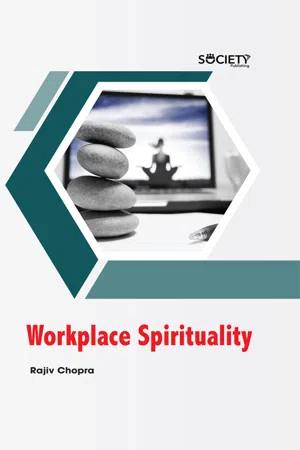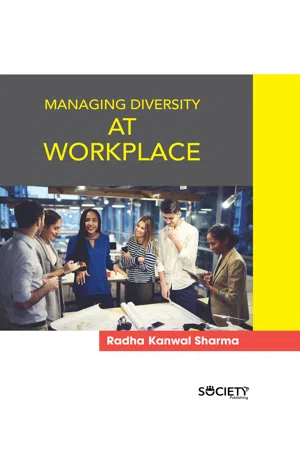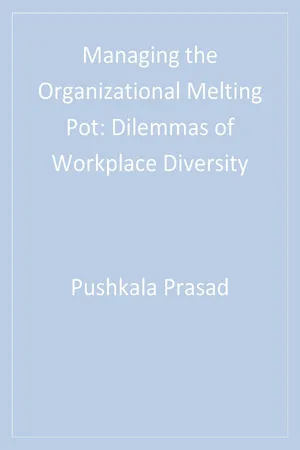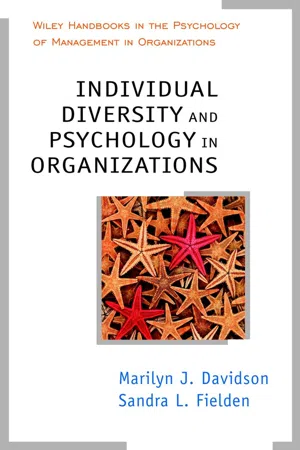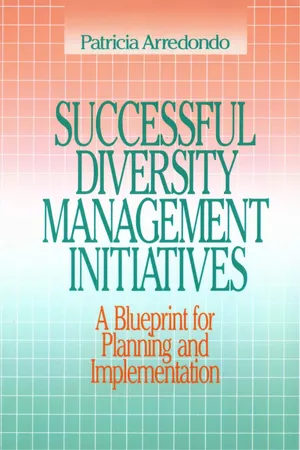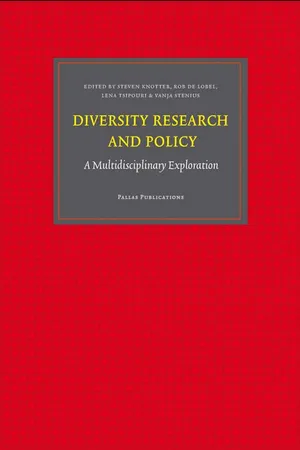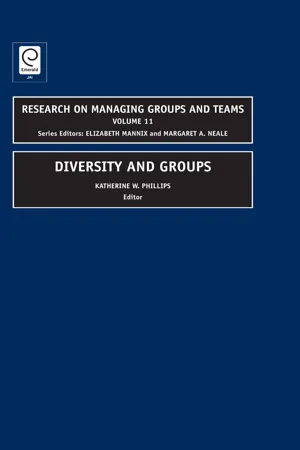Business
Diversity in the Workplace
Diversity in the workplace refers to the variety of differences among people in an organization, including but not limited to race, gender, age, ethnicity, sexual orientation, and physical abilities. Embracing diversity in the workplace can lead to a more inclusive and innovative environment, as it brings together a wide range of perspectives and experiences.
Written by Perlego with AI-assistance
Related key terms
1 of 5
10 Key excerpts on "Diversity in the Workplace"
- eBook - PDF
- Rajiv Chopra(Author)
- 2020(Publication Date)
- Society Publishing(Publisher)
In order to transcend the spirituality individual differences such as religious beliefs, age, sex, races as well as other features, everyone would require to have alike deeply-held values regarding spirituality. Diversity is any element that can be visible or invisible and used to transform people and groups from one another. The occurrence of workplace diversity under a workplace shows that the workplace is assorted Cultural Diversity and Workplace Spirituality 117 with respect to gender, ethnicity, as well as race in which employees attain different elements as well as qualities that are different from one another (Robbins, 2003; Buckingham, 2012). Workplace diversity is the understanding and acceptance of individual employee’s varied characteristics. Diversity in workplace is a reality in most businesses and organizations. In year 2004, workplace diversity is also defined by Hazard (2004) as a wide variety of differences that affect how people interact with each other within an organization and achieve business results. Workplace diversity is also known as workforce diversity. It can be explained as an organization or business in which employees attain different elements and qualities that differ from each another. The different elements mentioned above involve beliefs, values, and actions of employees that vary by gender, age, lifestyle, ethnicity, as well as physical abilities. Managing these elements can create problems related to an old way of staffing that are the main focus for human resource departments. There are many essential elements related to workplace diversity, issues related to workplace diversity as well as the management of workplace diversity. The motive of this study was to exactly explain the meaning of workplace diversity, explore how managing workplace diversity can influence diversity awareness as well as employees job satisfaction, and examine the policies and procedures associated with workplace diversity management. - eBook - PDF
- Radha Kanwal Sharma(Author)
- 2019(Publication Date)
- Society Publishing(Publisher)
Diversity training is equally important for managers and others in leadership positions in the company, so that they are able to guide their subordinates in case the need arises. • Effective communication : Communication is the key point in sustaining diversity. To bring everyone on the same page, there should be availability of all company policies especially the one related to diversity (equal employment opportunity, diversity and inclusion policy, prevention of discrimination and harassment, sexual harassment, LGBTs and their inclusion, appropriate and non-appropriate behaviors at work, grievance handling mechanism, and penalties in case of offences etc.) should be on company intranet and must be read by every employee. If the workplace has people from different linguistic backgrounds, these policies can be printed multilingual. Regular discussions and reminders about these should be communicated to all. Pictures and symbols that everybody can understand should be used wherever applicable. • Encourage interaction: Social interaction among employees should be encouraged. Diverse teams should be made and people should be given chance to network. Employees should be encouraged to mingle with those from different backgrounds. This networking allows them to know and understand each other. This bridges the information gaps, bringing closure to curiosity. People start to understand, appreciate and respect the differences that exist among them. They start to value each other and learn from each other’s perspectives, experiences and innovation starts to take place. Understanding Workforce Diversity 23 Thus, workforce diversity is somewhat challenging to manage, but encouraging and fostering it is the best way forward for organizations. It is a proven fact that diversity is the best business approach to tackle global business environment. A systematic approach can help the organization reach its diversity goals. - eBook - PDF
Managing the Organizational Melting Pot
Dilemmas of Workplace Diversity
- Dr. Pushkala Prasad, Albert J. Mills, Michael B. Elmes, Anshuman Prasad(Authors)
- 1997(Publication Date)
- SAGE Publications, Inc(Publisher)
More recently, other dilemmas have also emerged in reports on interracial hostility (Gates, 1993) and From Showcase to Shadow 13 minority frustrations (The Hidden Rage, 1993) in the popular press. We would like to briefly enter this shadow land of dilemmas to understand the more complex problems facing the implementation of Diversity in the Workplace. What Does Workplace Diversity Really Mean? Despite the intense publicity surrounding the diversity movement, the pro-cess of managing diversity itself remains within something of a black box. H o w do organizations conceptualize workplace diversity? Do these conceptualiza-tions differ from region to region and from industry to industry? H o w do organizations set goals and targets? How do they go about accomplishing them? H o w do managers evaluate the effectiveness of their diversity programs? These and other questions remain largely unaddressed by current discussions of diversity. Above all, the central hermeneutic question, what does diversity mean, is rarely addressed. As a result, we have a potpourri of popular views and opinions on what constitutes workplace diversity, without a serious considera-tion of the multiple and possibly conflicting meanings attributed to the term. We suggest that the concept of workplace diversity itself may not hold uniform connotations, signifying different things to different groups and indi-viduals within organizations and society. To some, diversity may be little more than proportional representation of various demographic and social groups in the workplace. To others, it may involve overcoming cultural prejudice and instilling new values about difference in the organization. To still others, it may connote changing the very fabric of work practices in keeping with the cultural influences of different social groups. At any rate, this more problematic reading of diversity deserves a closer examination by organization and management scholars. - eBook - PDF
Managing Risk in Communication Encounters
Strategies for the Workplace
- Vincent R. Waldron, Jeffrey W. Kassing(Authors)
- 2010(Publication Date)
- SAGE Publications, Inc(Publisher)
Second, a diverse popu-lation coupled with globalization creates a more diverse customer base. And third, culturally diverse workforces possess a greater variety of information and experience and may outperform homogeneous work-groups on creative and problem-solving tasks. While these arguments make good business sense, Konrad (2003) warned that they are also flawed in important ways. For example, simply positioning diversity as something to be managed ignores the ingrained interaction patterns within organizations that tolerate levels of stereotyping and discrimi-nation. Hiring diverse employees primarily to interface with customers of their own cultural group limits cultural group members to only these organizational roles, acting as a form of segregation. So workforce diversity can have a positive impact, but we cannot assume that it will. The Benefits of Workplace Diversity Workplace diversity appears to lead to organizational improvement in several areas (Hermon, 1996; Kirby & Richard, 2000). It can improve the balance of power and access to decision making within organiza-tions while bolstering employee competence, job satisfaction, job involvement, and organizational commitment (Kirby & Richard, 2000). In addition, workplace diversity initiatives have been shown to raise the sensitivity of senior managers to diversity issues and concerns, increase career opportunities for women and minorities, and improve interpersonal relationships among employees (Hermon, 1996). Thus, there appear to be some clear benefits derived from workplace Chapter 7 Dealing With Difference 139 140 MANAGING RISK diversity. Not surprisingly, corporations actively recruit culturally diverse employees. See Textbox 7.1, which features HERSHEY’S efforts to promote workforce diversity. - Marilyn J. Davidson, Sandra L. Fielden, Marilyn J. Davidson, Sandra L. Fielden(Authors)
- 2004(Publication Date)
- Wiley(Publisher)
Together, these factors indicate that many employers will seek to recruit women and older workers (although young people in full- time education continue to be available for part-time work). The second area emphasizes the harnessing of the human capital possessed by diverse groups. This argument holds that prejudice, discrimination and within-organization disadvantage create low morale and disaffection, which in turn lead to poor individual and organizational performance. Here, employers need to confront prejudice and discrimination and seek to eliminate them, so that human capital can be fully utilized. The third area is particularly concerned with the globalization of world markets and the international labour and product markets that many organizations operate within. It is believed that a diverse workforce can make a positive contribution to such organizations. From this perspective, it is worthwhile 10 developing strategic approaches to diversity policy organizations proactively seeking to recruit and retain diverse employees. The fourth area concerns customer markets. The assumption is that organizations could gain access to new markets by tapping the culturally specific experiences and insights that a diverse workforce possesses. Again, diversity adds value to the organization. To be effective in economic business terms, diversity policy would need to tackle the area(s) appropriate to the particular organizational context and circumstances. Placing the emphasis on a nar- row conception of the organizational benefits to be derived from diversity might result in a partial rather than comprehensive policy. For example, a narrow approach might render organizations more amenable to valuing certain types of diversity over others. There is no evidence to suggest that an organization that values gender diversity will necessarily place an equivalent value upon ethnic diversity, especially as women comprise overall a larger customer market than do ethnic minorities.- eBook - PDF
Successful Diversity Management Initiatives
A Blueprint for Planning and Implementation
- Patricia Arredondo(Author)
- 1996(Publication Date)
- SAGE Publications, Inc(Publisher)
For e x a m p l e , in o n e steel mill there are o n l y m a l e factory w o r k e r s ; to that extent they form a h o m o g e n e o u s g r o u p . T h e m e n v a r y in age, skill level, national heritage, a n d marital status, h o w e v e r , a n d thus they also form a d i v e r s e w o r k g r o u p . To capture the d y n a m i s m a n d variability of a d i v e r s e workforce, i n d i v i d u a l charac-teristics n e e d to b e d e s c r i b e d in l a n g u a g e that r e c o g n i z e s differences rather than creates arbitrary labels. T h e m e a n i n g of diversity w i l l v a r y a n d is subject to definition w i t h i n a particular organizational culture. Multiculturalism is often interchanged w i t h diversity. M u l t i c u l t u -r a l -p s y c h o l o g y specialists state that m u l t i c u l t u r a l i s m refers primarily to culture, ethnicity, a n d race (Sue, 1995; Sue, A r r e d o n d o , & M c D a v i s , The Domain of Diversity Management 17 1992). In fact, these are the categories utilized by the government, employers, market researchers, and other entities to record demo-graphic diversity. In U.S. society, the major categories in use are Asian, African, Hispanic/Latino, Native American, and Caucasian. This prac-tice introduces confusion, as the terms used make reference to both culture and race. This situation is most unclear with the Hispanic/Lat-ino category. There are categories on census forms for nonwhite Hispanics. Very simply, Hispanic is not about race. Diversity management refers to a strategic organizational approach to workforce diversity development, organizational culture change, and empowerment of the workforce. It represents a shift away from activities and assumptions defined by affirmative action to manage-ment practices that are inclusive, reflecting the workforce diversity and its potential. - eBook - PDF
Diversity Research and Policy
A Multidisciplinary Exploration
- Steven Knotter, Rob de Lobel, Lena Tsipouri, Vanja Stenius, Steven Knotter, Rob de Lobel, Lena Tsipouri, Vanja Stenius(Authors)
- 2012(Publication Date)
- Amsterdam University Press(Publisher)
The third issue addressed by the critical diversity literature is the role of the context in shaping the meaning of diversity. As already mentioned, some authors question whether diversity approaches and practices, inspired by de-mographic evolutions and cultural assumptions from the US, can be simply transferred to other (cultural or national) contexts with different diversity issues (Cassell & Biswas 2000, Jones et al. 2000, Kossek et al. 2006, Nyam-begera 2002). Consequently, they argue for an approach that studies diversity while acknowledging the wider social, political and historical context ( Jones & Stablein 2006, Nkomo & Cox 1996, Prasad et al. 2006) and how such el-ements affect the identities that become salient, the meanings attached to them, individuals’ positions within organisations and power differences be-tween them ( Jones & Stablein 2006, Kersten 2000, Litvin 1997, Nkomo & Cox 1996, Prasad et al. 2006, Siebers 2009a, 2009b). At the meso level, some critical scholars have worked on embedding understandings of diversity and unequal power relations in organisation-specific productive contexts, explor-ing the way work processes influence an organisation’s understanding of di-versity and the way it is managed ( Janssens & Zanoni 2005, Zanoni & Jans-sens 2004). This literature connects identities and the broader discourse of diversity to individuals’ (assumed) competences and value generation for the organisation, theoretically and empirically developing the idea that diversity is, at its essence, a business concept ( Janssens & Zanoni 2005, Zanoni 2009, Zanoni & Janssens 2004, 2007). - eBook - PDF
- Katherine W. Phillips(Author)
- 2008(Publication Date)
- Emerald Group Publishing Limited(Publisher)
In a more immediate sense, we would suggest that researchers explicitly acknowledge the role that team, organizational, or even extra-organizational context played in one’s choice of diversity attributes and related outcomes, study design and sample selection. For example, in the aftermath of a race riot in the surrounding community, a study of race/ethnic diversity in a particular organization in that community would acknowledge that race/ethnicity-based dynamics are likely to have different implications than age or gender diversity. In national contexts where immigration issues have taken center-stage, the role of immigrant status as a relevant diversity attribute may be more relevant than other attributes such as gender or age. From a methodological standpoint, the use of qualitative data to supplement survey-based techniques may provide a more in-depth understanding of what aspects of diversity are relevant in a particular organizational or work group setting. Further, incorporating contextual variables in research design would require the use of constructs at multiple levels of analysis; this has theoretical and methodological implications. Theoretically, such an approach requires greater integration between sociological, political, and psychological disciplines to examine the interplay between individual, group and organizational levels of analysis. Skaggs and DiTomaso (2004) presented an extremely comprehensive and multidisciplinary review of research on the effects of organizational demographics on workplace outcomes such as pay, career progression, job satisfaction, and perfor-mance. The authors integrated sociological, psychological, and management literatures to argue that status inequalities are perpetuated in organizations through managerial practices and can have implications for interactional processes between group members. - eBook - PDF
Managing Diversity in the Global Organization
Creating New Business Values
- Kenneth A. Loparo, Kenneth A. Loparo, Celia de Anca, Antonio Vazquez Vega(Authors)
- 2016(Publication Date)
- Palgrave Macmillan(Publisher)
Conclusions The reconciliation of supposed opposites in wider frameworks of action enables the coexistence of a wider range of points of view on the same problem. Nevertheless, it is important to signal that differences also present a series of challenges and can disorient the organization’s objec- tives. In order to avoid possible risks, organizations should provide clear and visionary leadership that is capable of placing the differences in a wider framework and managing possible tensions. Managers should establish clear rules and procedures that will be respected by all within a flexible framework of maneuver. Today’s companies, characterized as they are by their global scale and the changing environment in which they function, need above all to be capable of innovating and growing, and to do this they need to adapt to the potential of the diversity provided by their employees, who in turn need to grow and innovate, in a context in which they feel recognized and valued. In a labor market context, in which differences of gender, culture and personality are ever more marked, and in a changing economic environment it is not easy to decide which style of behavior is the most appropriate for the company: a multifaceted person capable of generating work rapidly in many directions, or a monochronical planner who is focussed on details and capable of producing rigorous work. Ideally, each person should be capable of both approaches, and training helps each to acquire the skills of the other. Nevertheless, whilst we are being trained to be more complete beings, we must learn to respect and enable the complementarity of differences. 96 PA R T O N E : U N D E R S TA N D I N G D I V E R S I T Y 97 5 Personality and Diversity Management Personality is one of the major areas of study in psychology today. We do not have scope in this book to explore the complexities relating to this topic, nor to discuss neurological and biological questions. - eBook - PDF
- Michael A. Hitt, C. Chet Miller, Adrienne Colella, Maria Triana(Authors)
- 2017(Publication Date)
- Wiley(Publisher)
25 U.S. Department of Labor, “Working in the 21st Century.” 26 Ibid. 27 U.S. Bureau of Labor Statistics, “Women in the Labor Force.” 28 U.S. Bureau of Labor Statistics, Dec. 19, 2013, Economic News Release, Table 3. Employment by Major Industry Sector, 2002, 2012, and Projected 2022 at http://bls.gov/news.release/ ecopro.t03.htm. 29 Ibid. 30 See, for example, S. E. Jackson and E. B. Alvarez, “Working Through Diversity as a Strategic Imperative,” in S. E. Jackson and Associates (eds.), Diversity in the Workplace (New York: Guil- ford Press, 1992), pp. 13–29. 31 U.S. Census Bureau, June 4, 2013, “U.S. Trade in Goods and Ser- vices,” http://www.census.gov/foreign–trade/statistics/historical/ gands.pdf. 32 U.S. Department of Commerce, 2007, “FT900: U.S. Interna- tional Trade in Goods and Services,” http://www.census.gov/ foreign–trade/press–release/current_press_release/press). html#current. Endnotes 65 33 M. A. Hitt, D. I. Ireland, and R. E. Hoskisson, Strategic Manage- ment: Competitiveness and Globalization (7th ed.) (Stamford, CT: Thompson Learning, 2007). 34 Whole Foods Market, 2007, “Our Core Values,” http://www. wholefoodsmarket.com/company/corevalues.html. 35 T. H. Cox and S. Blake, “Managing Cultural Diversity: Implica- tions for Organizational Competitiveness,” Academy of Man- agement Executive 5 (3) (1991): 45–56; Jackson and Alvarez, “Working Through Diversity as a Strategic Imperative.” 36 R. Eisenberger, R. Huntington, S. Hutchison, and D. Sowa, “Per- ceived Organizational Support,” Journal of Applied Psychology 71 (1986): 500–507; R. Eisenberger, P. Fasolo, and V. Davis– Lamastro, “Perceived Organizational Support and Employee Diligence, Commitment, and Innovation,” Journal of Applied Psychology 75 (1990): 51–59. 37 Cox, Cultural Diversity in Organizations; P. F. McKay, D. R. Avery, and M. A. Morris, “Mean Racial Differences in Employee Sales Performance: The Moderating Role of Diversity Climate,” Per- sonnel Psychology 61 (2008): 349–374.
Index pages curate the most relevant extracts from our library of academic textbooks. They’ve been created using an in-house natural language model (NLM), each adding context and meaning to key research topics.
